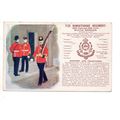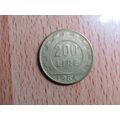Saffron Walden, Essex - cottage - art postcard
- Condition : Used
- Dispatch : 2 Days
- Brand : None
- ID# : 99587611
- Quantity : 1 item
- Views : 323
- Location : United Kingdom

- Seller : justthebook (+1703)
- Barcode : None
- Start : Sun 31 Mar 2013 05:13:37 (EDT)
- Close : Run Until Sold
- Remain : Run Until Sold
Checks/Cheques
 for 1 item(s) edit
for 1 item(s) edit
Shipping Calculator
More Listings from This Seller view all
Seller's Description
- Postcard
- Picture / Image: Cottage at Saffron Walden, Essex - drawing by R.V. Brown, Hockley
- Publisher: R.V. Brown
- Postally used: no
- Stamp: n/a
- Postmark(s): n/a
- Sent to: n/a
- Notes / condition:
Please ask if you need any other information and I will do the best I can to answer.
------------------------------------------------
Postage & Packing:
UK (incl. IOM, CI & BFPO): 99p
Europe: £1.60
Rest of world (inc. USA etc): £2.75
No additional charges for more than one postcard. You can buy as many postcards from me as you like and you will just pay the fee above once. (If buying postcards with other things such as books, please contact or wait for invoice before paying).
Payment Methods:
UK - PayPal, Cheque (from UK bank) or postal order
Outside UK: PayPal ONLY (unless otherwise stated) please. NO non-UK currency checks or money orders (sorry).
NOTE: All postcards are sent in brand new stiffened envelopes which I have bought for the task. These are specially made to protect postcards and you may be able to re-use them. In addition there are other costs to sending so the above charge is not just for the stamp!
I will give a full refund if you are not fully satisfied with the postcard.
----------------------------------------------
Text from the free encyclopedia WIKIPEDIA may appear below to give a little background information (internal links may not work) :
*************
Saffron Walden is a medium-sized market town in the Uttlesford district of Essex, England. It is located 12 miles (19 km) north of Bishop's Stortford, 18 miles (29 km) south of Cambridge and 43 miles (69 km) north of London. The town retains a rural appearance and many very old buildings dating from the medieval period onwards[citation needed] In 2001 the parish had a population of 14,313.
There has been a village on or near the site of present day Saffron Walden since before the Roman occupation of Britain[citation needed] when Bronze and Iron Age tribes settled in the area. After the Romans withdrew from the country, a flourishing Anglo-Saxon town was established[citation needed].
With the Norman invasion of 1066, a stone church was built. The castle was constructed c.1116[citation needed] A Priory, later to become Walden Abbey, was also founded under the patronage of Geoffrey de Mandeville, first Earl of Essex around 1136. The abbey was separated from the town of Walden by Holywell Field, which was enclosed in the sixteenth century to form part of the park of Audley End, the house of Sir Thomas Audley, who converted the abbey cloisters to a dwelling c. 1538-44[citation needed] The inner or Little Court of the seventeenth-century house corresponds to one of the cloisters.
In the medieval period the primary trade in Saffron Walden was in wool[citation needed] However, in the 16th century and 17th century the saffron crocus (crocus sativus) became widely grown in the area. The flower was precious, as extract from the stigmas, the saffron, was used in medicines, as a condiment, as a perfume, as an aphrodisiac, and as an expensive yellow dye. This industry gave its name to the town and Chipping Walden became Saffron Walden.
The town and the surrounding area, like much of East Anglia, was strongly Puritan during the 17th century. This area in particular was one heavily influenced by the Rev. John Eliot. By 1640, the Samuel Bass family and a number of others had departed for the Massachusetts Bay Colony as part of the wave of emigration that occurred during the Great Migration.[1]
Given its theological leanings and geography, seventeenth century Saffron Walden found itself at the center of the Eastern Association during the decade of the English Civil War. In the Spring of 1647, while serving as a New Model Army headquarters, the town was visited by then Lieutenant-General of Horse, Oliver Cromwell. The parliamentarian forces were internally divided at that time and Cromwell asked to see if compromise could be found that would reunify them in purpose and perhaps avoid another flare-up of civil war.
By the end of the 18th century the saffron flower was no longer in such demand, and the flower was replaced by malt and barley. In the 1830s there were more than 30 maltings and breweries running. Although this trade was not so rewarding as the saffron, the town continued to grow throughout the 19th century, having a cattle market and building a corn exchange and other civic buildings. During this time Quakers became very active in Saffron Walden, the most influential family being the Gibsons, who aided in the construction of several buildings that remain today, such as the museum[2] and the Town Hall.
The 1900s saw expansion of the Saffron Walden branch railway line that extended from Audley End, on the mainline from London to Cambridge, to Bartlow. This closed with the Beeching cuts in the 1960s.
type=printed postcards
theme=topographical: british
sub-theme=england
county/ country=essex
number of items=single
period=1945 - present
postage condition=unposted
Listing Information
| Listing Type | Gallery Listing |
| Listing ID# | 99587611 |
| Start Time | Sun 31 Mar 2013 05:13:37 (EDT) |
| Close Time | Run Until Sold |
| Starting Bid | Fixed Price (no bidding) |
| Item Condition | Used |
| Bids | 0 |
| Views | 323 |
| Dispatch Time | 2 Days |
| Quantity | 1 |
| Location | United Kingdom |
| Auto Extend | No |





















